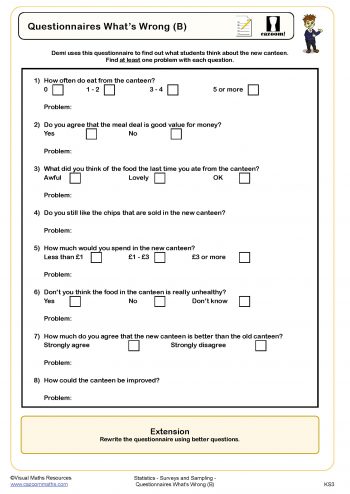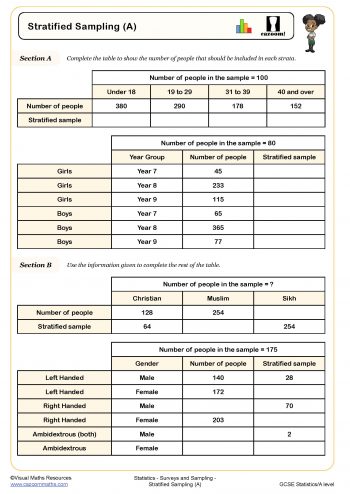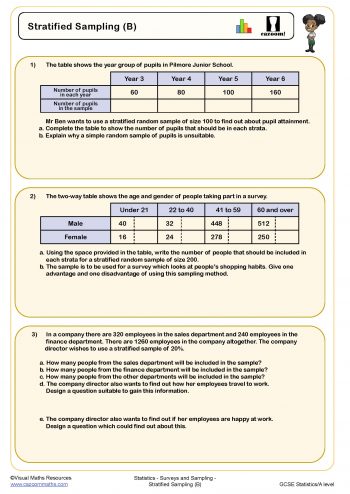Samples and Surveys Worksheets
Maths Worksheets / Statistics Worksheets / Samples and Surveys Worksheets
Our worksheets help kids master the art of surveys and sampling. Performing an effective survey and interpreting the data is a skill which students will come across in real life, so prepare them well with the sampling methods resources we have available at Cazoom Maths. We have resources available for all stages and all abilities, and all of our question sheets are supplied with answers so you can check how well students are doing and pinpoint areas for improvement. So whether you’re looking to help your child with stratified sampling or to guide your pupils through biased questions, our worksheets will help them with all they need to know. Our resources give students a thorough grounding in all topics related to surveys and sampling, and prepare them for any question they might encounter. All the information they need to know is presented in a clear and engaging format, breaking up the topic into manageable chunks and making this essential material easy to understand.
The Importance of Learning About Samples and Surveys
Businesses and researchers across all industries conduct surveys in order to collect data to help them answer a question or make informed decisions.
Any business which offers a product or a service to a customer might wish to know how they can improve, and to find this information they will invite their customers to complete a survey. Whenever someone needs to find out information, a survey will be useful.
Types of Samples and Surveys
There are many different things to consider when putting together a survey to make sure your results are unbiased and representative, so therefore it is important to learn about methods of sampling.
Different sampling methods will be suitable for different types of survey, and learning about these methods through clearly presented worksheets will help students master the skill of discerning between sampling techniques; a skill which they will definitely need for the future.
Teaching Samples and Surveys
Surveys and sampling worksheets are designed not only to help students work out how to create a sample set and perform a survey, but to analyse and understand the data gleaned from a survey.
This data might be displayed in several ways, for example a graph, or as a percentage. Therefore, learning about surveys and sampling can help children improve their skills in many other areas of maths.
Setting the Record Straight about Mathematics in Real Life
A survey of 1,300 children in a UK-based school showed that only 10 percent of students enjoy maths most of the time. Only 25 per cent are satisfied with their current level of mathematics education. Of those questioned, 80 percent believed maths to be completely useless for their futures.
Cazoom Maths resources will help you understand the true importance of learning maths of all types. Contrary to popular belief, at least among students, mathematics is vital to various aspects of everyday life. Everything from being able to halve or double recipes at mealtime to holding down executive positions at multinational corporations and paying monthly bills depends on analytical adeptness.
While various forms of mathematics play into any number of real-world scenarios, one of the most overlooked and underappreciated is samples and surveys. It’s often one of the most difficult for young people to grasp.
At Cazoom Maths, we offer a broad range of samples and surveys worksheets designed to help students master this numerical art, one they’re likely to use throughout their lives. At the same time, we provide resources for students in all stages of education and at all skill levels, from beginner to advanced.
What Are Samples and Surveys?
Simply stated, samples and surveys are portions of populations selected and asked specific questions. Those population members would be the samples, and the questions posed to them comprise the survey element of the equation. If carried out correctly, samples and surveys allow you to find out information about large groups of people using smaller, more manageable groups.
In most cases, choosing random samples is the best course of action because the whole point of these types of exercises is to glean unbiased information from them. For example, if you want to find out which foods are favourites among schoolmates, you wouldn’t ask only people you happen to know love pizza.
Instead, you’d select several students to survey from the entire student body, and pick subjects indiscriminately. One way to do this is by printing out a list of students, closing your eyes and simply pointing at names until you have as many as you need.
Why Are Samples and Surveys Important?
Samples and surveys are important for several reasons. Most notably, this type of data collection can provide conclusive information about an entire population without having to track down and question everyone involved.
Imagine being forced to gather answers from everyone in an entire country about ways to improve their lives. Doing so would be almost impossible. Then, picture only having to stand at a busy intersection and stop a few hundred people for questioning. Though you’d have fewer answers to work with, they’d be likely to represent the common opinions of all those who weren’t involved in the survey.
How Are Samples and Surveys Used in the Real World?
Samples and surveys are used continuously in the real world in virtually all industries and a broad range of everyday scenarios. Whether you’re looking for industry-specific applications or answers to real-life questions, you’ll find a place for this branch of mathematics. Some examples include:
- Marketing and Advertising: Marketing and advertising experts use samples and surveys to find out which ad campaigns and marketing strategies are the most effective for their clients.
- Politics: Political candidates rely on samples and surveys to find out which causes to stress during debates, to decide how to proceed with campaigns, to understand which portions of the population to address on various issues and to determine preliminary election results among other aspects.
- Real Estate: By looking at a small number of homes on the market and their surrounding circumstances, real estate experts can determine general property values for entire countries, counties or individual areas.
- Fashion: Fashion designers, clothing retailers and others in the industry can learn which items will best sell to the public by polling small categories of customers.
- Toy and Video Game Production: Those who develop toys and games present specific options to random groups of people and ask which ones they’d be most interested in buying to decide which projects are worth pursuing.
- Healthcare: Countless types of sample surveys are conducted to determine the health of the population, which illnesses and medical conditions are most common, which areas need better access to medical care and other important factors.
These are only a few of the instances in which samples and surveys come into play. Consider planning your own wedding. Because it would be impossible to make a unique meal for each guest, you’re trying to decide which two menu options to offer the 200 people expected to attend. Asking all 200 of them which foods they prefer would be extremely time-consuming, but polling only 20 guests would be much simpler and just as accurate.
Say 10 prefer steak, seven would rather have chicken, two ask for shrimp and one is a vegetarian. Using these numbers, you’d be well within reason to offer everyone a choice between chicken and steak because shrimp and no meat at all are the least popular alternatives.
Let’s move into the more in-depth aspects of samples and surveys. On the surface, it seems like a complicated field. Once you understand the basics, though, it becomes much less convoluted.
What Sampling Methods are Used for Surveys?
Several sampling methods are used for surveys, all of which fall into the category of either probability or nonprobability. Probability sampling methods are considered random and begin with all possible members of a population to be surveyed. From there, random participants are chosen. Nonprobability sampling methods, on the other hand, begin with only a specific portion of the group to be polled and are narrowed down from that point.
Nonprobability samples are often simpler to work with and less expensive from a business perspective, but they’re typically not as accurate. Probability methods can be more complicated, but they have a smaller margin of error.
Numerous sampling methods fall into these broader categories, each of which has its own set of benefits and disadvantages. You can learn more by exploring our selection of lessons and worksheets with answer keys to help you gain a better understanding of them.
Kent-born journalist, historian and science fiction writer, H.G. Wells once stated, “Statistical thinking will one day be as necessary a qualification for efficient citizenship as the ability to read and write.” (1) He may have been well ahead of his time with this line of reasoning, but his words couldn’t be more true.
Surveys and samples lie at the heart of statistics thinking, and maths in this branch give rise to a capacity for critical thinking, improved judgement skills and a better sense of logic among other vital abilities.
At Cazoom Maths, we’re dedicated to fostering these talents. Let our worksheets, answer keys and other resources help you build a strong foundation in this skillset so essential to so many aspects of the business world as well as everyday life.
Resource: College of William and Mary/Introduction to Statistics









